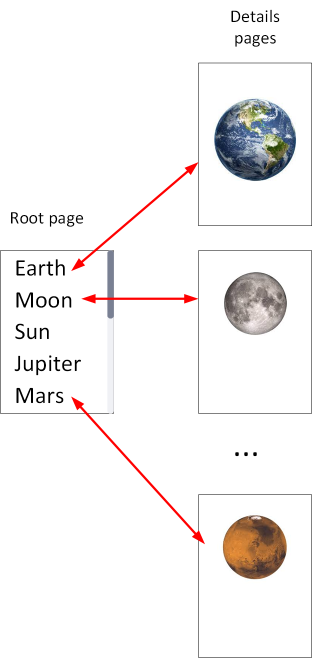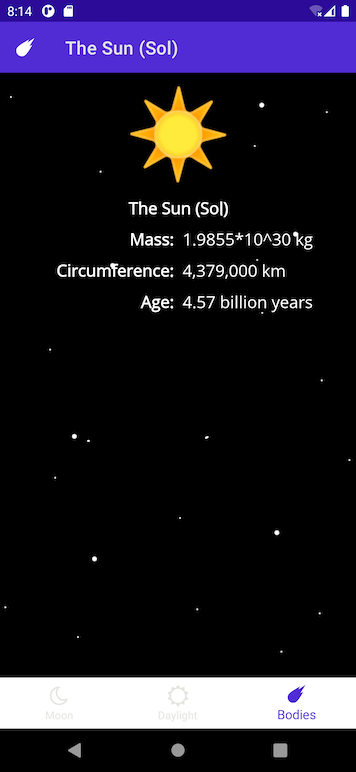練習:搭配使用索引標籤式頁面與導覽頁面
在天文學應用程式中,您被要求新增頁面,以讓使用者選取不同的天體,並顯示其詳細資料。 可能會有任意數的天體,因此為每個天體建立一個索引標籤不是可行的方式。 因此,若要讓使用者選取要檢視的天體,您可以決定新增另一個包含清單的頁面。 使用者可以從此清單中選取一個天體,而應用程式會在新頁面中顯示該天體的詳細資料。 清單頁面可作為堆疊導覽的「根頁面」。 您可將清單頁面新增為現有使用者介面中的索引標籤。

開啟入門解決方案
移至存放庫中您在本課程模組開頭所複製的 exercise3 資料夾,然後移至 start 資料夾。
使用 Visual Studio 開啟 [Astronomy.sln] 解決方案或 Visual Studio Code 中的資料夾。
注意
此解決方案包含未在您先前練習中所使用應用程式版本中的頁面。
在 [方案總管] 視窗中,開啟 Pages 資料夾。 除了 MoonPhasePage、SunrisePage 和 AboutPage 檔案之外,此資料夾還包含另外兩個頁面:
AstronomicalBodiesPage。 此頁面包含四個按鈕,可讓使用者選取太陽、月亮、地球或哈雷彗星的詳細資料。 應用程式的目前版本只是概念證明。 未來,此頁面可讓使用者從較大的清單中選取。
AstronomicalBodyPage。 此頁面用來顯示天體的資訊。
AstronomicalBodiesPage 已新增為按一下 [天文學] 飛出視窗時所顯示頁面上的索引標籤。
新增詳細資料頁面的路線
若要巡覽至 AstronomicalBodyPage,您需要在 AppShell 類別的建構函式中註冊一個路由來設定該路由:
public AppShell() { InitializeComponent(); Routing.RegisterRoute("astronomicalbodydetails", typeof(AstronomicalBodyPage)); }
瀏覽至詳細資料頁面
現在,我們需要執行導覽。 在 AstronomicalBodiesPage.xaml.cs 中,為該頁面上的每個
Button建立按一下事件處理常式。public AstronomicalBodiesPage() { InitializeComponent(); btnComet.Clicked += async (s, e) => await Shell.Current.GoToAsync("astronomicalbodydetails"); btnEarth.Clicked += async (s, e) => await Shell.Current.GoToAsync("astronomicalbodydetails"); btnMoon.Clicked += async (s, e) => await Shell.Current.GoToAsync("astronomicalbodydetails"); btnSun.Clicked += async (s, e) => await Shell.Current.GoToAsync("astronomicalbodydetails"); }每當按一下
Button,該應用程式就會導覽至 [AstronomicalBodyPage] 頁面。 但我們仍需要傳送要顯示的天體類型。若要將資料傳送至 [AstronomicalBodyPage],請在路線資訊中新增查詢參數字串。 字串的格式為
?astroName=astroBodyToDisplay。btnComet.Clicked += async (s, e) => await Shell.Current.GoToAsync("astronomicalbodydetails?astroName=comet"); btnEarth.Clicked += async (s, e) => await Shell.Current.GoToAsync("astronomicalbodydetails?astroName=earth"); btnMoon.Clicked += async (s, e) => await Shell.Current.GoToAsync("astronomicalbodydetails?astroName=moon"); btnSun.Clicked += async (s, e) => await Shell.Current.GoToAsync("astronomicalbodydetails?astroName=sun");若要在 [AstronomicalBodyPage] 上接收資料,請先建立類別層級屬性來保存傳入的資料。 將其命名為
AstroName。string astroName; public string AstroName { get => astroName; set { astroName = value; // this is a custom function to update the UI immediately UpdateAstroBodyUI(astroName); } }在這裡,
UpdateAstroBodyUI(astroName)是一種協助程式函數,可用來在設定AstroName屬性時立即更新使用者介面。然後您需要使用註釋來裝飾類別,而此類別會將您所建立的屬性對應至傳入的查詢參數。
[QueryProperty(nameof(AstroName), "astroName")] public partial class AstronomicalBodyPage { ... }啟動應用程式,然後選取標題為 [天體] 的索引標籤。
選擇 [太陽] 按鈕。 [太陽] 的詳細資料應該隨即出現。 導覽列應該包含「上一步箭號」,以讓使用者返回天體清單。 其餘索引標籤仍然會顯示且為使用中:

關閉應用程式,並返回 Visual Studio 或 Visual Studio Code。